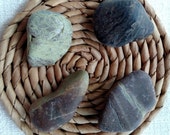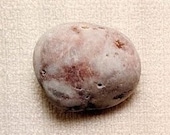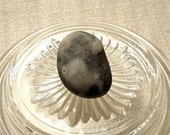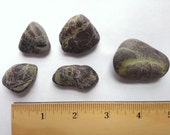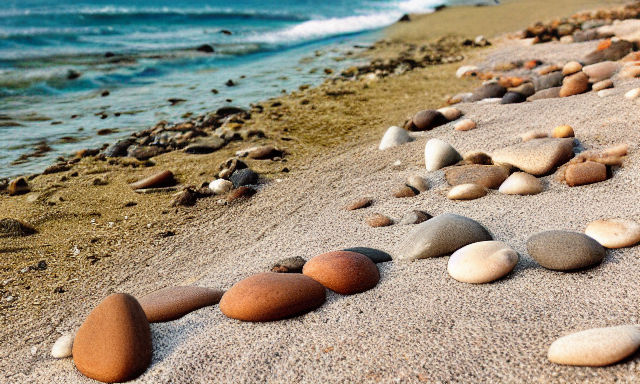Exploring the Mystique of Basalt Beach Stones in the Northeast
The Northeastern coastal regions of the United States are a geographical wonderland, rich in geological history and natural beauty. Stretching from the rocky shores of Maine to the sandy beaches of New Jersey and beyond, this region tells the story of eons past through its distinctive landforms and the stones that grace its shores.

A Brief Overview of Northeastern Coastal Regions
The Northeastern coastal regions encompass a diverse array of landscapes. From the rugged and dramatic coastlines of Maine, dotted with iconic lighthouses, to the picturesque sandy beaches of Cape Cod, and further down to the vibrant and bustling shores of New Jersey, this region offers a rich tapestry of geological formations. Its rocky cliffs, sandy dunes, and pebbled shores are a testament to the ever-changing face of the Atlantic Ocean.
The geology here is shaped by a history of glaciations, tectonic activity, and the ceaseless work of wind and water. Coastal bluffs and headlands formed by ancient glaciers watch over the beaches, which have their own tales to tell.
Introduction to Basalt Beach Stones
Among the treasures hidden within the Northeastern coastal landscapes, Basalt Beach Stones are captivating and enigmatic. These unique stones bear the hallmarks of the ocean’s relentless sculpting power, showcasing their journey through time.
Unique Characteristics
Basalt Beach Stones are known for their distinctive characteristics. These dark, often black or deep gray stones are the product of ancient volcanic activity. Their smooth, often polished appearance is the result of countless years of erosion by the ocean’s waves, which have refined these stones into nature’s works of art.
The Basalt Beach Stones, scattered along the shorelines, exude a sense of mystery. It’s as though they hold the secrets of the ocean within their dark, glossy surfaces.
These stones vary in size and shape, from small, palm-sized pebbles to larger boulders that are as massive as they are mesmerizing. Whether resting on the sand or tucked among rocky outcrops, Basalt Beach Stones are more than just geological remnants; they’re storytellers.
Coastal Beach Stones
The Formation of Basalt Beach Stones
How Do Basalt Rocks Form?
To understand the mystique of Basalt Beach Stones, one must delve into the geological processes that have shaped these captivating beachcomber finds.
Volcanic Origins: Basalt Beach Stones trace their origins back to volcanic activity. Basalt, an extrusive igneous rock, is formed when molten lava erupts and cools rapidly on the Earth’s surface. This lava, enriched with iron and magnesium, results in the dark coloration and unique mineral composition of basalt.
Solidifying Lava: The lava flowing from volcanic eruptions can span vast areas, and as it rapidly cools, it solidifies into basalt rock. The speed of cooling contributes to the characteristic fine-grained texture of basalt.
Formation over Millennia: Over millions of years, the forces of nature come into play. The basalt rocks are exposed to weathering, tides, and the ceaseless ebb and flow of ocean waves. It’s during this extended period that they are meticulously carved and polished, gradually evolving into the Basalt Beach Stones we find today.
What Do Basalt Rocks Look Like?
Basalt Beach Stones are distinct in appearance, characterized by their dark, often black or deep gray color. These stones exhibit a fine-grained texture that is a direct result of the rapid cooling of lava upon contact with the Earth’s surface.
Colors and Shades: The most common shades of Basalt Beach Stones are various tones of black and gray. The intensity of color can range from nearly pitch black to shades that incorporate subtle hints of gray or even a faint greenish hue.
Smooth, Polished Surfaces: An intriguing aspect of Basalt Beach Stones is their remarkably smooth and polished surfaces. This is primarily due to the abrasive action of the ocean’s waves, which have refined these rocks over millennia. As the stones are tossed and tumbled by the sea, they gradually become sleek and attractive.
Diverse Shapes and Sizes: Basalt Beach Stones come in an array of shapes and sizes. Some are small and palm-sized, while others are larger and might even be classified as boulders. Their forms can be rounded and well-worn, or they may feature angular edges, depending on the specific forces of nature they’ve been exposed to over time.
As with any geological formation, the unique characteristics of Basalt Beach Stones are a testament to the intricate processes that have shaped them. From volcanic eruptions to the ceaseless work of the ocean, each stone along the Northeastern coastline has its own story to tell.
| Myth and Mystery of Basalt Beach Stones | Description |
|---|---|
| 1. Lore of the Healing Stones | Legends suggest that basalt beach stones were once believed to possess healing properties. They were often used in ancient rituals to soothe ailments. |
| 2. Guardians of Elemental Balance | In some cultures, basalt stones are thought to be guardians of elemental balance. They were used to maintain harmony between the earth, water, fire, and air. |
| 3. Connection to Ancient Traditions | Many indigenous communities regarded basalt stones as sacred objects with ties to ancient spiritual practices. |
| 4. Beach Stone Amulets | Basalt beach stones were often carved into amulets or charms believed to bring protection and good fortune to those who carried them. |
| 5. Navigation and Wayfinding | Some coastal communities used basalt stones as markers for navigation, aiding sailors and travelers along their journeys. |
| 6. The Enigma of Singing Basalt Stones | In some folklore, basalt stones were said to produce musical sounds when struck gently, leading to their nickname “singing stones.” |
| 7. Nature’s Ancient Canvas | Unique rock art was created by indigenous people using basalt beach stones as a medium, illustrating the stories of their culture. |
| 8. Tales of Giants and Ancient Beasts | Ancient myths sometimes connected basalt stones with giants, ancient creatures, and epic battles of mythological proportions. |
The Geological Wonders of Basalt
How Basalt Is Formed
Basalt’s formation is a geological marvel that is closely tied to volcanic activity. Understanding why basalt is abundant in coastal regions involves peering into the Earth’s tumultuous processes.
Magma in the Earth’s Mantle: Basalt’s journey begins deep within the Earth’s mantle, a semi-solid layer that lies beneath the Earth’s crust. Here, molten magma, laden with iron and magnesium, is created due to the melting of rock. This magma is less dense than the surrounding solid rock, causing it to rise.
Volcanic Eruptions: When this magma breaches the Earth’s surface through volcanic eruptions, it is known as lava. Basalt is exclusively formed from lava of low viscosity, allowing it to flow rapidly. As this lava emerges, it cools and solidifies quickly, preventing the growth of large crystals and resulting in its fine-grained texture.
Abundance in Coastal Regions: Coastal regions offer a unique setting for the formation of Basalt Beach Stones. Volcanic islands, underwater volcanic activity, and the intersection of terrestrial landmasses with oceanic crust all play a part. The volcanic activity in these areas results in the effusion of basaltic lava into the surrounding waters. When this lava cools rapidly upon contact with seawater, it solidifies into the distinctive basalt rock we find along the shorelines of the Northeast.
Balancing Rocks – Cairns
How Are Basalt and Granite Formed?
While both basalt and granite are igneous rocks, they differ significantly in their formation.
Basalt Formation: As previously discussed, basalt is born of volcanic eruptions. It arises from low-viscosity lava that quickly cools at the Earth’s surface, producing a fine-grained texture. The fast cooling prevents the growth of larger crystals and results in the dark coloration we associate with basalt.
Granite Formation: Granite, on the other hand, forms from magma that is more viscous. This molten rock, also rich in minerals, cools much more slowly deep within the Earth’s crust. The leisurely cooling allows the development of larger crystals, giving granite its distinctive coarse-grained appearance. In contrast to basalt’s dark hues, granite often exhibits lighter colors.
Comparing these two rock types showcases the fascinating variability in the Earth’s geological processes. Basalt’s rapid cooling results in its fine-grained texture and coastal prevalence, while granite’s slower cooling creates its coarser-grained composition and a different geological disposition.
Understanding these distinctions sheds light on the rich geological history of coastal regions, where the formation of Basalt Beach Stones unfolds as a natural masterpiece.
The Distinctive Features of Basalt Beach Stones
Basalt Beach Stones are intriguing not only for their origins but also for their unique properties. Let’s delve into the distinctive features that make them stand out.
What Can Basalt Be Used For?
Basalt’s utility extends far beyond the confines of the beach, finding applications in various domains. Some notable uses include:
1. Construction Material: Due to its durability and resistance to weathering, basalt is often employed in construction. It can be found in roads, bridges, and even as reinforcement in concrete structures.
2. Paving Stones: Basalt’s natural beauty, combined with its hard-wearing nature, makes it an excellent choice for paving stones. Whether it’s a garden path or a driveway, basalt adds a touch of elegance.
3. Art and Sculpture: Many artists appreciate basalt for its workability and attractive dark color. Sculptors craft intricate pieces from this stone, enhancing the artistic appeal of spaces.
4. Massage and Therapeutic Stones: Basalt’s ability to retain heat makes it a preferred choice for massage stones. When heated, it can provide a soothing and therapeutic experience.
5. Cookware: Some culinary enthusiasts use basalt cooking stones to prepare unique dishes. The stone’s heat retention qualities help in even cooking.
Can Basalt Be Polished?
Basalt can indeed be polished to a smooth, shiny finish. This enhances its aesthetic appeal and makes it more versatile for various applications. The smooth surface resulting from polishing can be used for artwork, sculptures, and even architectural accents. It’s worth noting that the fine-grained texture of basalt can achieve a particularly sleek and elegant appearance when polished.
Can Basalt Be Magnetic?
Basalt itself is not inherently magnetic. However, certain basalt rocks might contain traces of magnetic minerals like magnetite. This can result in localized magnetic properties, making some basalt samples mildly magnetic. While not a defining characteristic of basalt, it’s a fascinating aspect to consider in the realm of rock magnetism.
Can Basalt Float on Water?
Basalt is denser than water, so it typically does not float. In contrast to pumice, which is known for its buoyancy due to its porous nature, basalt is much denser. It will tend to sink when placed in water. However, the specific gravity of basalt can vary depending on its composition and porosity, so some very porous basalt stones might exhibit a degree of flotation in certain conditions.
The Charm of Basalt Beach Stones
Basalt Beach Stones have an undeniable allure, attracting both collectors and geology enthusiasts. Let’s explore some essential aspects of these captivating stones.
Should I Store Basalt Stones a Certain Way?
Preserving the beauty and integrity of your Basalt Beach Stones is crucial. To store them properly, consider the following:
1. Dry and Ventilated Space: Store your basalt stones in a cool, dry, and well-ventilated space. This prevents moisture buildup and reduces the risk of mold or mildew.
2. Avoid Direct Sunlight: Prolonged exposure to direct sunlight can cause color fading in some basalt varieties. Opt for a shaded storage location if your stones are particularly vibrant.
3. Protective Padding: To prevent scratches or chipping, place a soft padding like cloth or felt between stones if you’re stacking or storing them together.
4. Display Cases: If you wish to showcase your collection, transparent display cases provide a protective barrier against dust and physical damage.
Where Can Basalt Rocks Be Found?
Basalt is not a rare sight in the Northeastern coastal regions. It’s particularly prevalent in areas with a history of volcanic activity. Coastal states like Massachusetts, Connecticut, and New Jersey feature intriguing basalt formations. When exploring these regions, you’ll likely encounter an assortment of basalt beach stones.
Where to Find Basalt Stones in Nature
Beachcombers often seek the thrill of discovering Basalt Beach Stones in their natural habitat. Here are some popular spots in the Northeast where these distinctive stones can be found:
1. Cape Cod, Massachusetts: The Cape Cod area, including beaches like Coast Guard Beach, often yield remarkable basalt beach stones.
2. Rye, New Hampshire: Rye’s beaches are known for their diverse collection of beach stones, including striking basalt specimens.
3. Martha’s Vineyard, Massachusetts: This picturesque island is home to numerous beaches with fascinating basalt formations.
4. Long Island, New York: Beaches along Long Island’s North Shore, such as Orient Beach State Park, are excellent for beachcombing and basalt stone hunting.
Are Basalt Stones Valuable?
The value of Basalt Beach Stones largely depends on various factors, including their rarity, uniqueness, and the interests of potential buyers. While these stones may not possess the intrinsic value of gemstones, they hold immense value for collectors and enthusiasts. Additionally, basalt’s versatility and utility in construction and art make it a valuable resource.
However, the true worth of basalt stones is often personal. Collectors appreciate them for their natural beauty, geological significance, and the sense of wonder they bring. To determine their monetary value, consulting with experts or appraisers in the field can provide insights into the specific worth of your collection.
Creative Uses and Beyond
Basalt Beach Stones, with their unique properties, have a wide range of applications that go beyond the shoreline. Here, we delve into the creative and practical uses of these remarkable stones.
What Is Basalt Stone Used For?
Basalt is a versatile rock with numerous applications:
1. Construction: Basalt’s durability and resistance to wear make it an excellent choice for construction materials. It’s used in building roads, bridges, and concrete aggregates.
2. Landscaping: Basalt is a popular choice for landscaping due to its natural, earthy appearance. It’s used in pathways, walls, and garden features.
3. Art and Sculpture: Artists often choose basalt for its workability and the aesthetic appeal of its dark color and fine texture.
4. Massage and Wellness: Smooth, heated basalt stones are used in hot stone massages, renowned for their relaxation and therapeutic effects.
5. Metaphysical Uses: Some believe basalt stones have healing properties and use them in spiritual practices and alternative medicine.
What Is Basalt Stone Made Of?
Basalt is primarily composed of three minerals:
1. Plagioclase Feldspar: This mineral gives basalt its characteristic color, which ranges from gray to black.
2. Pyroxene: Pyroxene minerals, like augite and hypersthene, are common in basalt and contribute to its hardness.
3. Olivine: Although less common, olivine can be found in some basalt varieties, adding a hint of green to the rock.
How Long Do Basalt Stones Hold Heat?
One of the remarkable qualities of basalt is its ability to retain heat. Basalt stones, when heated, can hold their temperature for an extended period. This feature makes them ideal for various applications, such as hot stone massages, where the heat is transferred to the body gradually for relaxation and therapeutic benefits. The exact duration of heat retention varies with the size and thickness of the stone, but it can last for hours.
How Does Basalt Turn Into Sandstone?
Basalt and sandstone are distinct rock types formed by different geological processes. Basalt is a fine-grained, dark-colored igneous rock, while sandstone is a sedimentary rock composed of sand-sized mineral particles.
The transformation of basalt into sandstone does not occur under natural geological conditions. Sandstone forms through the accumulation and compression of sand-sized grains (usually quartz) over vast periods. In contrast, basalt originates from solidified lava or magma.
These rocks represent different stages in the rock cycle, with basalt being igneous and sandstone being sedimentary. There is no natural process by which basalt can directly change into sandstone.
What Is the History of Basalt?
The history of basalt is intricately tied to the geological history of the Earth. Basalt, as an igneous rock, has a rich history dating back millions of years. It forms from volcanic activity, and the Earth’s crust has experienced numerous volcanic eruptions over its long history. This geological wonder has been instrumental in shaping landscapes and, in some cases, creating new landmasses.
Basalt is found in regions with a history of volcanic activity. The Northeast, with its connection to the Appalachian Mountains and rift valleys, has a significant geological history marked by volcanic events. Basalt deposits can be linked to volcanic eruptions from the distant past, adding a layer of historical depth to these coastal stones.
Where Does Basalt Rock Come From?
Basalt, as a rock type, primarily originates from solidified lava flows. When volcanic eruptions occur, they release molten lava, which, upon reaching the Earth’s surface or cool ocean waters, cools and solidifies rapidly. This solidification process transforms the lava into basalt rock.
Marine Origins: In coastal regions like the Northeast, some basalt formations are the result of lava cooling upon contact with seawater. This interaction forms distinctive columnar basalt structures. For instance, the famous Giant’s Causeway in Northern Ireland showcases these unique formations, created by volcanic activity millions of years ago.
Volcanic Plate Boundaries: In areas near tectonic plate boundaries, such as the mid-Atlantic ridge, intense geological activity has led to the formation of basaltic rock. This rock is often found in the vicinity of these tectonic plate margins.
Why Does Basalt Have Small Crystals?
Basalt is characterized by its fine-grained texture, with small, often microscopic, crystals. The size of these crystals is primarily due to the rapid cooling of lava on the Earth’s surface or under the ocean. When molten lava solidifies quickly, there isn’t enough time for large crystals to form.
The smaller crystals in basalt result from the lava cooling at a rapid rate, locking in the mineral structures before they can grow larger. In contrast, rocks with larger crystals, like granite, cool slowly beneath the Earth’s surface, allowing mineral grains to develop and grow to a visible size.
This rapid cooling is a distinctive feature of volcanic rocks like basalt, and it gives them their characteristic fine-grained texture.
Is Basalt a Stone or Salt?
Basalt is indeed a stone, not salt. This confusion might arise from the similar-sounding names, but they represent entirely different substances.
Basalt: Basalt is an igneous rock formed from solidified lava or magma. It is dense, durable, and often dark-colored. Basalt is commonly used in construction, art, and various other applications due to its unique properties.
Salt: Salt refers to sodium chloride (NaCl) or other chemical compounds formed by the reaction between an acid and a base. Salt is a mineral and is typically not used as a building material. Instead, it’s a common seasoning and preservative in the culinary world.
It’s essential to differentiate between the two, as they have distinct properties and applications in various industries.
Exploration and Appreciation
Let’s take a closer look at basalt beach stones found in the Northeast, discuss how and where to purchase them, and explore their significance for collectors.
Basalt Beach Stones in the Northeast
The Northeastern coastal regions are not only known for their picturesque landscapes and charming beaches but also for the unique geological treasures they hold. Among these natural wonders are basalt beach stones. These stones are particularly fascinating because they bear the geological history of the region.
Geological Significance: Basalt beach stones in the Northeast are closely tied to the region’s geological history, which includes volcanic activity and tectonic plate movements. The formation of these stones can be traced back millions of years, and they tell a story of ancient volcanic eruptions and the ever-changing Earth.
Distinctive Appearance: Basalt beach stones in this region are typically dark-colored and may exhibit fine-grained textures. They often have irregular shapes, smoothed by the relentless action of ocean waves. These stones bear the marks of their journey through time, shaped by natural forces.
Where to Buy Basalt Stones
For those interested in obtaining basalt stones for personal or artistic purposes, it’s essential to know where to find them. Here are some tips on acquiring these unique stones:
1. Online Marketplaces: Several online marketplaces and websites specialize in selling a variety of stones, including basalt. You can explore these platforms to find basalt stones of different sizes and shapes.
Coastal Beach Stones
2. Rock and Gem Shows: Attending rock and gem shows or mineral exhibitions is an excellent way to source basalt stones. These events often feature a wide range of minerals and stones for sale.
3. Specialty Stone Stores: Some specialty stores, especially those dealing with landscaping or stone sculptures, may carry basalt stones. Visiting these stores can provide you with the opportunity to handpick the stones that best suit your needs.
4. Local Beaches: If you’re located in or near the Northeastern coastal regions, beachcombing can be an exciting way to find basalt beach stones. Keep in mind that removing stones from natural habitats should be done responsibly and with respect for the environment.
Basalt Beach Stones: A Collector’s Delight
For stone enthusiasts and collectors, basalt beach stones hold a special place. Here’s why they are considered a collector’s delight:
Unique Geological History: Basalt beach stones are not just ordinary rocks; they represent the geological history of the region. Collectors are drawn to the intriguing story these stones tell about ancient volcanic events and the forces that shaped the Earth.
Aesthetic Appeal: Basalt stones are known for their beauty. They come in a range of dark colors, often with intriguing textures and patterns. These qualities make them highly sought after by collectors who appreciate their aesthetic value.
Artistic Potential: Basalt beach stones are not only appreciated as natural wonders but also as artistic mediums. Stone sculptors and artists often use basalt due to its workability and its capacity to hold intricate details.
Conversation Pieces: Basalt beach stones can be fantastic conversation starters. Displaying these stones in your home or collection allows you to share the story of their formation and their connection to the Northeastern coast with others.
In the world of geology and natural beauty, basalt beach stones are true marvels. From their intriguing formation to their captivating appearance, these stones have a unique place along the Northeastern coastal regions. Let’s sum up the fascinating journey into the world of basalt beach stones, exploring their formation, uses, and the distinct charm that makes them a collector’s delight.
The Formation of Basalt Beach Stones: In our exploration, we delved into the geological processes that birth these stones. We learned that basalt rocks are the result of ancient volcanic activity, and their distinctive characteristics are shaped over millennia by the relentless forces of nature.
The Geological Wonders of Basalt: We compared the formation of basalt with other rock types, such as granite, to gain a better understanding of its abundance in coastal regions. This comparison highlighted the uniqueness of basalt and its significance in the geological tapestry of the Northeast.
The Distinctive Features of Basalt Beach Stones: We found that basalt is not just a pretty face but a versatile stone. It can be used for creative and artistic purposes, polished to a shine, and even possesses magnetic properties. Moreover, its surprising buoyancy adds to its intrigue.
The Charm of Basalt Beach Stones: Properly storing basalt stones is essential for preserving their unique characteristics. Furthermore, we provided insights into where you can find these beach stones in nature and discussed their value to collectors.
Creative Uses and Beyond: Basalt stones, beyond their geological significance, offer a world of creative applications. They can be turned into works of art, possess a mineral composition that sets them apart, and are known for their exceptional heat-retention properties.
Curious Questions: We explored the history of basalt, tracing its origins and discussing why it exhibits small crystals. Clarifying common misconceptions, we affirmed that basalt is indeed a type of rock, not salt.
Exploration and Appreciation: In the Northeastern coastal regions, basalt beach stones tell a story that spans millions of years. For those eager to acquire these unique stones, we outlined where and how to find them. We also emphasized their significance in the world of stone collecting.
We encourage you to explore the captivating beaches of the Northeast to discover the natural wonders that are basalt beach stones. These unique geological treasures have much to offer, from their aesthetic beauty to their rich geological history. The next time you stroll along the shoreline, keep an eye out for these intriguing stones, and let their mystique captivate your imagination.
With this comprehensive guide, we hope you’ve gained a deeper appreciation for the world of basalt beach stones in the Northeast. Their presence along these coastal shores is a testament to the ever-evolving geological processes that continue to shape our planet.

